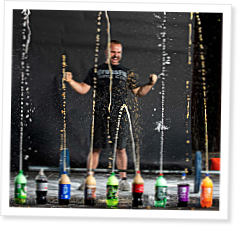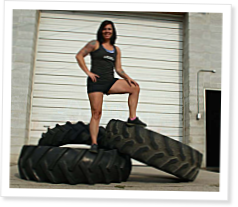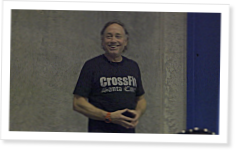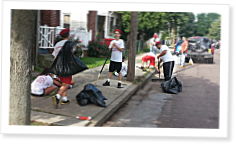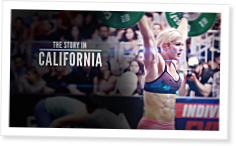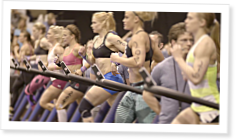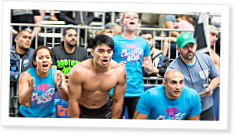by Michael Bennett
By Difu Wu via Wikimedia Commons
“I told myself that if the science got me out of there, insofar as it was up to me, I would do everything to keep this train moving, physically and mentally. I knew then that even I was not arrogant enough to think I would ever ‘beat’ cancer, but I would do everything in my power to keep it at bay.”
Read More
var addthis_config = {"data_track_addressbar":true};
When Mark asked me to share my personal experience overcoming chronic illness, I spent much thought wondering how I would present it in a manner that would be appropriate for the intended audience. I knew I couldn’t do the Starting Strength program much justice, seeing how I am just a beginner in its practice, even though the principles it upholds are the same as what helped me. If I can offer any value, it’s in the telling of my story of chronic illness, the physical adversity I went through, and how fitness helped me survive it.You see, I’m just an average guy who loves life and is always trying to do what is best for himself. As is usually the case, anything I figure out on my own I usually find that someone else has figured it out better long before I came along. That’s the amazing part of being human: learning from the experience of others and using it to improve yourself.So, here goes…According to the National Center for Health Statistics, the average weight for an adult male in the United States is 190 pounds. This as a guide, at 6′2″ 180 pounds is slender, but has the graceful appearance of a swimmers body. I was 145 pounds, hollow eyes and gaunt face, frail, and weak. I had one or more IV’s that somehow managed to provide constant fluids, a morphine drip on command, and around-the-clock chemotherapy. I had a plastic jar in the bed beside me because I could not get up to go to the bathroom under my own power. When I finally did get up, I saw myself for the “first time” in a full-length mirror. “I look like a Skeksis,” I thought. I finally realized what a wreck I had become, physically. My mind, too, would have looked very much the same: I was intellectually barren. I could no longer even remember simple words I used so casually beforehand.When white blood cells take over your body your spleen becomes enlarged, like mine did, causing terrible pain. This is because the spleen is the garbage collector for white blood cells. When it receives cells that do not die in exceedingly gross amounts, it clogs and swells up. The other thing is that white blood cells represent your immune system, so it is true to some extent that a human with increased white blood cell production is very well protected from diseases and viruses – until there are so many that they can’t accomplish anything. Your body is at war with itself and the one that suffers is you.I do not recall having anything to vomit in during my first hospital stay, which is strange, because I threw up frequently for days. I do remember that after they moved me to a sterile room that I simply leaned over the bed and threw up in the trashcan. I did not think much of it then and there was no time to react. I remember feeling terrible about it and apologizing to the janitor.The first day was the simplest, fundamentally. I was very fortunate. Most people come into a serious, life-changing event and find God, swear to change who they are and how they are going to live. I did not have to struggle with that epiphany. I did not regret a single moment. I knew before my body began to shut down on me that life was too short not to take chances, that I had to enjoy what I had, that I wanted to do better, be better, and appreciate life for what it is. I was mature in that way, but up until that first day I always thought, “If my time comes, it comes.” I was surprised to find out that my answer to the most fundamental question was not so resolute. I realized I wanted more.
I wanted to see my wife again.
I wanted to see my kids.
I wanted to see my dog.
I wanted to see my family.
I wanted to have a great steak.
I wanted to feel a fall breeze on my face.
I wanted to smell honey suckle.
I wanted to swing.
I wanted to barbecue.
I wanted to travel.
I wanted to live longer.
After that, the rest was easy. I told myself that if the science got me out of there, insofar as it was up to me, I would do everything to keep this train moving, physically and mentally. I knew then that even I was not arrogant enough to think I would ever “beat” cancer, but I would do everything in my power to keep it at bay. Later, I would understand just how much was actually up to me, what I had province over, and how strong my resolve would really be.How To Get Leukemia.I remember being in a hospital ward filled with other kids. I remember being stuck in bed for a long time. I remember having my temperature taken by way of the rectum and how uncomfortable I was about it (ah, the seventies). I remember kids coming over to my bed to play and eventually I was able to get up and move about the room a little.I don’t know how long I was there, but found out later that it was because I had pneumonia. I was very young, somewhere around six years old I suspect. I don’t know how it happened or why, but it is clear that my immune system would forever be compromised as a result. From that point on I had regular health problems.Forward about 25 years. I am seeking out challenges and overcoming obstacles. I have two great fears that I haven’t conquered: spiders and the workings of automotive mechanics. Spiders are obvious, but I always had a terrible fear of a car breaking down and leaving me in despair. Maybe it was some deep rooted psychological issue or maybe it was just being broke and alone in the middle of nowhere with no recourse that bothered me. In the end I had to know and understand it to overcome that fear.{pagebreak}Now I am working at my uncle’s transmission shop. You may not know it but spiders love the underside of cars. It makes a great natural and safe habitat, and it’s warm. They nest there. So I am killing two birds with one stone.About two years in I am starting to get pretty good at it. I am starting to not only understand transmissions, but overall car mechanics as well. I am even starting to pick up on how certain models of car have unique problems. I have a good level of comfort, a few challenges, and now I know enough that I no longer fear what can happen if my own car breaks down. I can diagnose it and fix it.Then one week I am sick, as sick as I have ever been. My uncle is on vacation and he calls in to check on everything. I tell him I need to take a few days off, I am really really sick. We have customers waiting for cars and lots of work – without the whole crew working together we won’t get through. So I do something I can’t recall ever doing in recent memory: I go against principle. I do something I disagree with and know is wrong. I hang in there, suffer, and get through the work.But while I am deathly sick something else is happening. I am working with chemicals, parts cleaners, oils, fluids. My immune system is weak. The perfect storm is here and I have no idea. It wouldn’t be until five years later that it all comes together and I realize that a few days as a mechanic would change the rest of my life.Parts of two chromosomes have exchanged places – translocated – and now I have a genetic mutation called the “Philadelphia chromosome”. My body makes them now, they don’t die, and they are slowly killing me, day by day, for the next two years until my body crashes and I am hospitalized. Then I find out I have chronic myelogenous leukemia.In the next few years I learn that CML is not genetic, it’s environmental. I learn that this chromosomal defect can be caused by several chemicals, including benzene. I learn the chemicals I used at the transmission shop contained benzene. I learn that while other mechanics have worked with these chemicals for decades, something was different about me. I learn about the immune system and how it works, and how it can be compromised.If I had never been diagnosed with CML I still wouldn’t have given this history any thought. I wouldn’t care about colds or flus. I wouldn’t be donating to bone marrow organizations or leukemia drives. I wouldn’t have any pieces to put together. If I had taken a few days off this article wouldn’t exist and I would be living a normal life, none the wiser. I probably wouldn’t care about my health or fitness or what it means.In the search for answers over time the pieces come together. This is how it all happened.TransplantFast forward ten years.Chemotherapy is a poison and it has finally taken its toll. I’m at the end of my life. My body can’t take anymore. Ten years of daily chemotherapy, in pill form, was my limit. The only chance I have to go on living is an archaic process that is literally a coin flip and where surviving is usually worse than dying: a bone marrow transplant.For my situation and type of transplant, 50% of the patients survive the first year and of those, 50% survive five years. I’m closing in on three years at the time of this writing.Before being stuck in that hospital bed with leukemia, one of my goals was getting in shape. I had seen Fight Club and determined that I would get ripped up like Brad Pitt, but that idea had been suspended momentarily in time. It wasn’t long, however, before I was out of that hospital and at it again, back to work, reaching for goals, and over the next seven years getting in the best shape I would ever be in my life.In that decade I battled with leukemia I learned a lot, rejected a lot, and changed a lot about my training. I always challenged prevailing trends and always questioned why I was doing something so that I could assure I was doing what was best for me. Ultimately, though, my body told me what I could and couldn’t do. I got real good at listening.If you do enough research you are going to come across some things that are true. That is how it was for me and fitness. Unfortunately, most of what I found was wrong. In fact, it was down right dangerous. When you are fighting through chronic illness, its “cure” and the subsequent consequences, you don’t have a lot of slack when it comes to making fundamental errors. Mistakes can cost you.Since undergoing transplant I’ve had deep vein thrombosis, embolisms, loss of hair, severe peripheral and autonomic nerve damage, fibromyalgia, infections, shortness of breath, vertigo, shattered teeth, body rash, and dozens of other health issues. But I never quit, never gave up, and never relented because I wanted more life. I did what my body would allow, when I could, the best I could with the hope that I would get the benefits long term.StrengthOne overall truth in particular stands out today. The foundation I built when I was “healthy” made managing and recovering from transplant easier. That foundation was strength. The body remembers. When it is time to recover, getting healthy is much easier when you have already laid the foundation and can return to it. And if you have the foundation, you can do what you want with it – build at the pace you set, change the esthetics, make it better, be stronger. In those moments I often doubted if anything I had done or did was helping, it was impossible to say. Now I know it did.The first thing I would tell anyone newly diagnosed with chronic illness is to start to build a foundation. The first thing I would tell anyone else is, start to build a foundation. After two and a half years of staying the course and managing the transplant, things started to improve. I started to slowly recover and make some physical gains again, albeit with great difficulty. The period of maintenance and waiting was over. Time to check on the foundation. My goal was to rehabilitate a body that had been through the wringer. Physically, I was still experiencing severe joint pain, tendon pain, bone pain, muscle pain, cramps, and fatigue. I needed to work through all that and make progress again.But even in this electronic age of communication, with so much information, opinion, expertise, and media presentation I was hard pressed to find anyone who could actually explain why the methods they preached should be practiced, let alone applied to a guy in my unique circumstance. So I started to research and understand – really for the first time – underlying bone, muscle, tissue, and tendon structure, how to improve and strengthen their function, and apply it specifically to my condition.That’s when I came across Mark Rippetoe.{pagebreak}Someone had written two lines in a forum mentioning his name and his book. I can’t remember exactly what it said, but it was something like, “This guy explains why we do what we do. Required reading.” That brief explanation was enough for me to go to Amazon and read the reviews. I ordered Starting Strength right away.Even after years of training I found myself learning from his book immediately (by immediately, I don’t mean the next chapter, but the very next sentence). I had never trained in pure strength and never thought it was for me, but I was sold on the “foundation” idea immediately because I always believed that, and had always tried to do that; I just never understood it or trained it from a Starting Strength perspective.Now, I am a 45-year-old male who has been through some serious adversity. I am not going to compete in the Olympics or be in the World’s Strongest Man competition. I just wanted to be better and stronger. Being stronger would make me more useful in general and harder to kill. Being stronger than I have been in my life didn’t even enter my thought process.But that’s exactly what has happened.While I knew that the concepts presented were perfectly sound, I wasn’t sure about many of the specifics offered in Starting Strength – the training days schedule, the very few barbell exercises taught being enough, the Valsalva technique, or the practice of fives as being the right guideline for building strength – things contrary to what I had been told previously, but I couldn’t disagree with any of Mark’s reasoning. So I simply followed the program as prescribed, and after two months the results, for me, have been amazing and significant on their own.The most weight I had ever moved in any barbell exercise in my life, at my peak, was 225 pounds for no more than three reps, total. Now I have added ten or five pounds per week and currently, after two months, I am lifting the following according to the Starting Strength program:
Squat: 250
Press: 115 (I was bench pressing 210 before deciding it was not a good idea to continue, due to shoulder issues)
Deadlift: 265That’s from a guy who was stuck in a hospital bed for far too many days memorizing the ceiling. Not only am I getting stronger, but I’m stronger than I have ever been in my life. After just two months everything I do in life is getting easier as a result – going up stairs, lifting couches, riding my hog…this shit really works!Now I am in a position to look back and revisit what I learned about training from the perspective of someone dealing with chronic illness – from the moment that I didn’t know the difference between dumbbell and barbell, through transplant, and to the present, with a better understanding of how body mechanics work and should be employed. I have gone beyond what I ever thought would have been possible. I cannot guarantee that if you are in the exact same situation as me and do exactly what I did that you will make it. I can guarantee you that I did some things that drastically improved my odds. It broke my heart to see some fellow patients go through it much worse simply because they had no idea that preparing their bodies beforehand would make the difference.From that perspective, here is what little I can offer, now a little wiser.Is Training Important?This is the first question that needs to be answered and one I struggled with throughout. When I was lying there at the mercy of chromosomes, drugs, and human competence I was quite sure that my body didn’t care that I ate steak every night, that I was a good person, or that I exercised and took good care of myself. That is because, in the throes of such a difficult time, it is hard to see the whole picture. Plus, it’s just hard as hell.Training plays an important role in anyone’s life, regardless of whether or not you are healthy or sick. Being fit has proven benefits: you are stronger, more resilient, have better endurance, can better manage the onset of disease, absorb digestive material better, greater stability and mobility, and improved flexibility to name a few. Training simply makes the human machine better, regardless of circumstance. Mark sums it all up and I wish I knew this as concretely when I started: “Strong people are harder to kill than weak people and more useful in general.” Every time I read that I laugh, not because it’s a funny thing to say, but because it is so fundamentally true as to be almost obvious, yet constantly evades understanding. If you have any doubt as to this truism, doubt no further. I proved it. Exercise and the Immune System.There is certainly more to overcoming chronic illness than just lifting weights and getting strong. There is nutrition, medication, managing side effects, the illness itself, the ups and downs, the psychology, support, caregiving, setbacks, stress, bad doctors, misdiagnoses, and deficiencies in knowledge, to name a few. Training is just one component, but I know it is a major one.The scariest thing I ever had to consider was whether or not exercise could actually hurt me during times of recovery. If exercise is so good, and I need to do it to get better, what is going to happen if I’m not allowed to do it? Some evidence says that moderate exercise can help strengthen the immune system temporarily, while strenuous exercise can weaken it. The exact how and why isn’t fully understood, but several studies suggest this. In my specific case, my immune system is actually trying to kill me (that is because when you get a bone marrow transplant you get someone else’s marrow, i.e., immune system, and that immune system thinks your body is the enemy). So, conceivably, there are situations for any chronic illness that may limit or even contraindicate exercise altogether.So could strength and conditioning training actually make things more difficult? Some day science will give us this answer conclusively. (Editor’s note: Probably not.) For me, it was a balance of making adaptive progress while listening closely to my body. I was an extremely unusual case. My conclusion, based on the fact I am writing this, is that adaptive strength training, no matter how slow or difficult at times, is the component that is paramount to surviving chronic illness and transplant. You have to outperform the complication, and the variables are simply how and how much. Allowing the body to deteriorate at the mercy of prevailing obstacles, without fighting, is giving in to dying. You must not concede this.Even at my very worst I can also say that exercise (any exercise) provided a distraction, a sense of accomplishment, relief, gain, and confidence. It is just one more thing that resembles the old, healthy life, one more thing that points to the return of normalcy.{pagebreak}What training did I do?There are activity-specific exercises added to improve areas of sport performance, whether it’s gymnastics, MMA, long distance running, boxing, and so forth. So, is there leukemia training? Or bone marrow transplant training?Yes! But it starts with training systemically.For a chronic illness and procedure like I had, the training concepts applied are the same for anything on two legs, regardless of its present physical efficacy. It applies whether you want to simply walk up and down steps easier, or pursue absolute physical excellence. What I didn’t fully realize in the beginning and wish I knew better is again best summed up by Mark so eloquently:“You do not need to do many different exercises to get strong – you need to get strong on a very few important exercises, movements that train the whole body as a system, not as a collection of separate body parts. The problem with the programs advocated by all the national exercise organizations is that they fail to recognize this basic principle: the body best adapts as a whole organism to stress applied to the whole organism. The more stress that can be applied to as much of the body at one time as possible, the more effective and productive the adaptation will be.” In my personal experience, any side effect of illness or treatment which precludes the execution of stress applied as a whole can be reduced to smaller functional parts (as much of the body as possible) without losing the benefit of adaptation. And in dire situations where smaller functional movements cannot be produced, move anything.A significant factor in my survival was this: I didn’t wait to be transplanted to suddenly take up the torch of training. I came in with it. A large chunk of work was already done. After that, it was just a matter of continued doing.Obstacles Out of Our ControlI hated when doctors responded to my sometimes poor results by saying, “Everyone is different” (translation: We have absolutely no fucking idea what is happening to you), but it does hold a point here. Not everyone has blood clots which limit exercise during recovery. Not everyone has an allergic reaction that keeps them down for weeks. Not everyone has the exact timing of experiences. Many were worse off than me. The point is that everyone has something to deal with. But there is a difference between “can’t” and “won’t.” So long as the answer is “won’t”, then you can overcome an obstacle.How much you can overcome that obstacle at any given time may well vary based on circumstance. Don’t despair. Effort always results in progress and continued progress turns into results- the only undetermined variable will be time. Enjoy the progress in the moment and know that there is a benefit coming longer term. But you have to put in the effort and that is simply a choice.MaintainingWhen time is indeterminate and it seems like nothing is happening, you sometimes have to maintain. This is especially true with severe or chronic illness. Is essence, the idea is to try and hold on until you can get back to “normal.” No one can survive cancer treatment indefinitely without serious side effects. All you can do is hedge your bets and put yourself in the best possible scenario for when it ticks upward again. And the fact is that if you stick with it, your chances are always going to be accumulatively better.Maintaining is where a lot of people give up. It wears on them. It wore on me. But even under the strain of constant suffering, there are always days, hours, or even minutes that present themselves as opportunities. In the beginning of my transplant recovery, the goal proposed to me was to get out of bed and do a lap around the hallway of the patient rooms (maybe fifty feet). That first lap left me exhausted and unable to move for two days. I did that for a while. Then I worked up to two laps. Then every day. Then five minutes straight. Then fifteen minutes. Sounds like adaptive training, doesn’t it?RecoverySo if you hedge your bets and survive long enough, you get the chance for further recovery. The new obstacle is what your body will allow consistently. I can tell you that it is disconcerting to feel like you sometimes have no say in the matter, but if training is important to the human body and allows for better living, certainly you would want to reestablish your routine as soon as possible. So you start with walks around the block, then two blocks, then bike riding, then light body weight exercises, resistance bands, weights, and on and on, progressively – see a pattern here? And you start to feel stronger and healthier. Then a setback occurs and you are hospitalized for a few days. Now the focus is to fix the problem that sets you back. Once that is done, you may have to start over from scratch and just walk around the block again. That is okay because your body didn’t forget. You get right back into rhythm and in a few days you are right back to where you were in your training. Then something else happens and now you are set back a week. Again, you overcome it and everything is fine for a while. Then something else happens and it’s a month. In times like those training doesn’t matter in the moment – for me it took a dozen or more drugs to get going again. All that new work is in the future, waiting, ready to start again.I started over, literally, at least fifty times. The pursuit of health and well being comes naturally to anyone who wants to be in a better position than they were previously. With chronic care it’s just a lot harder and frustrating because there are so many breaks in routine and valleys to traverse to get to that better health. Everything is set against you. And it’s even harder if all the work put in previously appears to be slowly lost in time because the body can’t keep up.That’s why it’s called recovery.{pagebreak}RestAfter writing this I came back and added Rest because it is more important than training. Without rest, there can be no recovery. Anyone battling to live won’t need to worry, there is going to be plenty of rest, but there are two things I found important. One, not worrying because you are inactive – accept what the body needs. And the second thing goes back to “can’t vs. won’t”: rest when you need it, not when you don’t. The body/mind connection can play some great tricks. Don’t let it fool you. I was always surprised at what I was capable of when I didn’t want to do it.NowToday I come in around 232lbs, fit, solid, and strong. I am making new gains using the Starting Strength program (as of this writing I added to all three movements again). To say I am stronger than I have been in the last ten years would go without saying, of course, but can you believe I am now stronger and healthier than anyone around me who is twenty years my junior? I have energy, cardio, and general strength that applies to any adventure I find myself in, and I am happier and healthier overall. That ideas about strength are so simple and can be so beneficial is amazing. That someone like Mark can present it in such a clear and concise way, so that anyone can benefit, is truly wonderful and appreciated.When I underwent transplant I was asked to participate in an exercise study to correlate the benefits of exercise on transplant survival. When they asked me to meditate fifteen minutes a day and count my steps I knew I probably wasn’t going to get too much benefit personally. I described above how walking for a transplant patient is extremely taxing, a challenge, and to a point adaptive, but for me that didn’t last long. I exceeded the productive effects of walking pretty quickly. During my time with leukemia and subsequent transplant, physical well-being played zero part in patient survival either before, during, or after. One of the most significant aspects of survival is virtually unknown to the medical community: no one understands the role of a foundation of strength and its importance in overcoming illness. It is black hole science. There are some indications that change is in the future, but it is completely up to the patient to pursue, figure out, and execute. No one has a greater interest in your survival than you, so until help arrives, see to it.I no longer care to look like Brad Pitt. Instead I feel like I think someone who looks like Brad Pitt would feel like: strong, powerful, healthy. Everyone who sees me can’t believe what I went through, what I endured, and everyone wants to know how I made it. I hope this helps.For me, a large part of my life consisted of strength and conditioning as a means of survival. Now, as I am older and putting those trials behind me I find a whole new life opening up. This suits me well. As I understand, things that are older often seem to just generally work better. That is true.I do not hold any certifications in fitness or degrees in physiology. I simply have my experience and the outcome. The outcome would be impossible unless the fundamentals were true. If everything I did turned out to be wrong, or improperly executed, I can step back and rebuild based on an incontrovertible axiom: movement is life. As long as I know that I can fix the rest. So can anyone else.Mark, thank you for your work, diligence, and commitment to understanding physical strength, and thank you for Starting Strength: Barbell Training. Anyone who is willing to think, challenge what they believe, and continue growing can benefit from this book. I wish I had had it sooner, and all the benefits offered. And I hope that every person sitting in that god awful transplant clinic discovers the lessons for themselves.It’s never too late to survive, and live. Michael Bennett is an average guy who pursues constant happiness, always tries to do better for himself, and sometimes fancies himself a writer of philosophical and literary fiction. He has lived a better life than most and, perhaps, better than he deserves.He and his wife, Renee, raised two wonderful daughters. One is a teacher and the other is in college to be a nurse. He worked in business process improvement for a decade while going to night school to earn his BA in IT, after which he developed software in the financial industry.He was diagnosed with leukemia in his thirties, underwent a bone marrow transplant, and is currently a semi-retired survivor pursuing and enjoying more life. His journey with health and fitness has been honed primarily by circumstance.He has an Italian Greyhound named Chopper, rides a 1992 Honda Shadow 600VLX, and has had the love, affection, and support of his high school sweetheart for the last 30 years.

